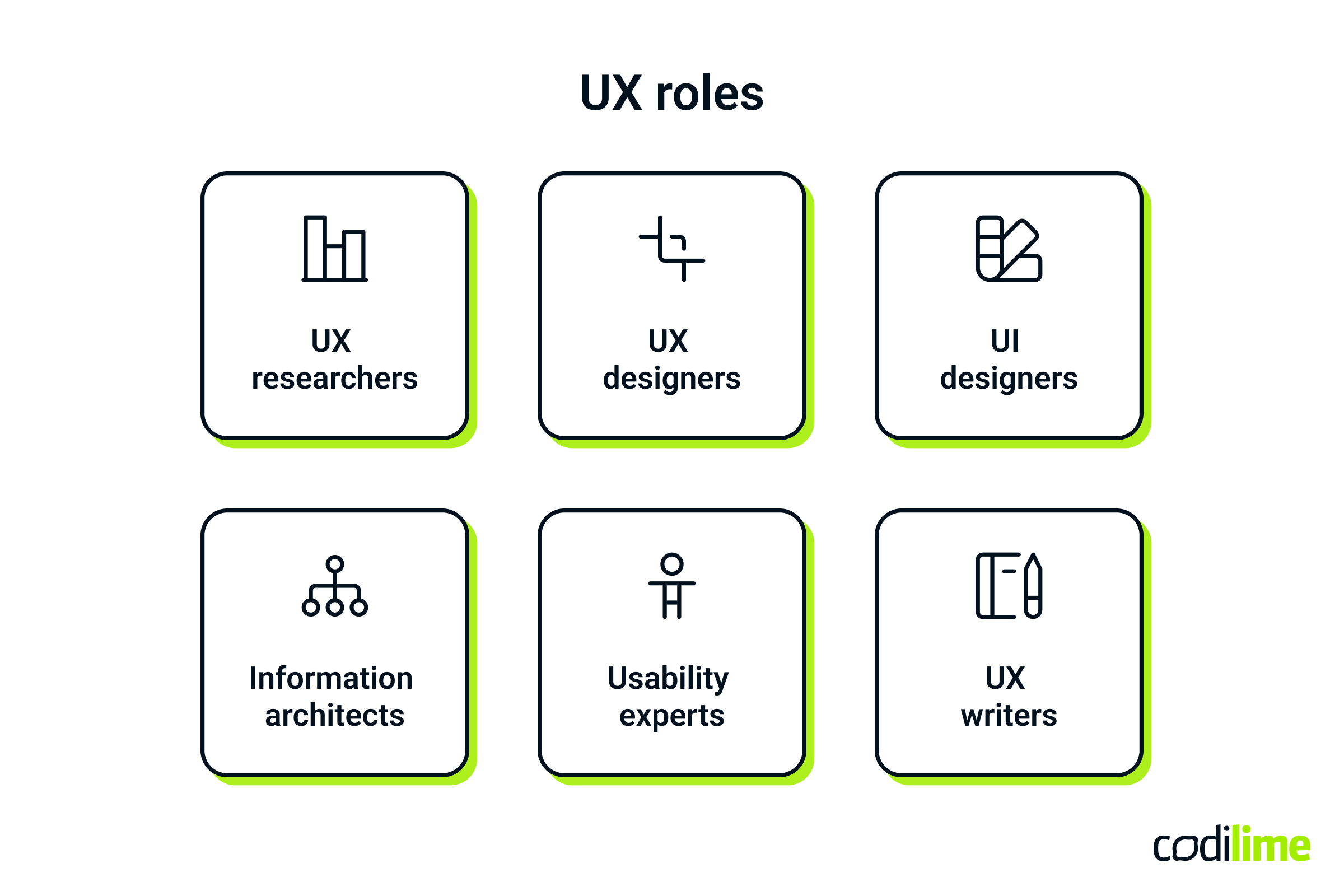Nowadays, more and more businesses recognize the value of UX design. The world is increasingly digitized, and companies can no longer offer only good service, they need to offer a good experience too. User research, UX research, and UX design have become critical to company’ssoftware development success. There is a growing demand for UX teams and UX designers who can create better user experiences and, in consequence, better products. Let’s explain what a UX design team is, the UX team structure,what their role is, and how to create successful UX teams.
What is a UX team?
A UX team is a group of professionals who aim to make a product’s user experience as rewarding and delightful as it can be. They want users to reach their goals and get what they came for in the easiest and most pleasurable way possible.
UX professionals usually comprise numerous specializations working together to create a productive team. They should have excellent communication skills and be open to receiving constructive feedback that encourages them to perform better. UX team members should learn collaborative skills and understand how such skills help the business in general. Finally, they should design for the customers and not themselves.
What does UX stand for?
It is a user experience, referring to any interaction a user has with a product. It’s about users both thinking and feeling while using the product. UX design is a process of creating conditions that are more likely to lead to a positive impression. Simply speaking, the goal of a UX design team is to build a digital product – a website, a web or mobile application, etc. – that is practical, desirable, findable, and usable.
What is the role of a UX team?
UX team members do whatever it takes to serve the design process. They perform multiple tasks to create a final design. They are concerned with the entire process of acquiring and integrating a product, including aspects of design, usability, and function.
UX designers work in a team to deliver the highest possible value to the customer. They are responsible for the UX design process. Let’s break down the whole process into given phases to better understand the UX design team’s role.

Product brief
During this phase, the UX team works on understanding stakeholders’, product owners’, developers’, and clients’ involvement in their environment for the product that they will design. The most important thing is to understand and clarify the business goals, what the business wants to build and why. The desired outcomes of this phase include user personas, user stories, journey mapping, use cases, and user flows.
UX research
UX research is a fundamental phase of the UX design process, consisting of market analysis and user research to establish a UX benchmark. The main idea behind this phase is to get into the target audience’s mind and create the right proposal for them. UX team members need to understand the possible problems and create a way to find solutions. The desired outcomes of this stage include ideas and materials that will be used in the design work, user interviews.
Sketching and design
During this phase, UX designers start the design process by creating an initial design of the product based on the established user personas. They clarify how the product fits into the life of the customer. This stage includes sketching, wireframing, and prototyping. The desired outcomes of this phase include sketches, wireframes, paper prototypes, mockups, user flows.
Testing and implementation
A series of tests are run to watch users as they interact with the product. The desired outcomes of this phase include a developed product with complete functionality and experience, based on multiple tests.
Evaluation
UX team roles don’t end after the product launch, they are needed for as long as the product is in use. Existing products should be continuously checked to ensure that they continue to satisfy customer needs. The desired outcomes of this stage include user feedback, audit reports, A/B tests, areas marked where improvement is required.
What are the roles in a UX design team?
As already mentioned, UX team roles are quite comprehensive. UX comprises many different disciplines so the best way to understand the UX team structure is to get to know the key UX roles and their responsibilities.
A UX team usually consists of at least six core roles: UX researcher, UX and UI designers, information architect, usability expert, and UX writer. Below, there are short descriptions of each UX role.

UX researcher
UX researchers engage with users to understand their needs, pain points, and behaviors. UX researchers plan and conduct research sessions and analyze the data gathered. They step into customers’ shoes to see how they feel about the product.
UX designer
UX designers make products and services usable, accessible, and pleasurable for end-users. They are also responsible for the UX design process (including testing prototypes). They ensure the practical execution of the design and how it is perceived by the users. Learn about the difference between UX designer and product designer.
UI designer
UI designers focus solely on the visual look and feel of the product – they create high-fidelity mockups and clickable prototypes of the digital product's interface. Following validated low-fidelity mockups, UI designers work closely with UX designers and developers to ensure that the product is visually appealing, accessible (WCAG) and easy to navigate.
Information architect
Information architects run user surveys, user interviews, and usability tests, as well as grouping and labeling content so that users can find the information they need quickly and easily.
Usability expert
Usability experts test the design for optimal user experience through different strategies.
You can read more about the differences between usability and user experience.
UX writer
UX writers are responsible for all the text a user encounters when they navigate the product (welcome screens, error messages, buttons, and notifications). They also ensure that brand guidelines are followed at each step along the way and the perfect message is sent.
Do UX designers always work in a team?
The entire process of creating good UX design involves a great amount of teamwork. A UX designer tends to work most effectively within a team. Their tasks touch on many different departments and they need to collaborate effectively with all of them to ensure the product is a success. Therefore, teamwork is one of the essentials when it comes to UX team competencies. Designers cannot operate in a vacuum – the entire UX team has to work together toward the same goal.
What is the role of a UX lead?
Sometimes it’s quite challenging to manage and organize all the information according to the agreed strategy. Especially because UX design is not a linear process. A UX lead is the person who ensures that every member of the team is on the same page and no conflicts are affecting the design. Another responsibility of a UX lead is striving to eliminate any problems. It’s their role to make sure that the project is completed with no compromises on quality.
How are UX teams structured?
UX team structure defines the responsibilities of all team members. What that should look like in your company depends on many factors: resources, product needs, company culture, etc. However, most UX teams use one of three common models:
Centralized
A centralized approach is one of the more common solutions. The team members report to a UX team leader or UX manager. Designers work on multiple projects and tasks for the company, and they are kind of consultants to the rest of the business. For instance, when a product team needs UX support, the UX manager understands the requirements and assigns one of the UX team members to that project. There is one UX manager who oversees performance, and steps in when changes are necessary.

Embedded or decentralized
This is a UX team with multiple team members that includes UX as one of a variety of areas of expertise, instead of having a separate UX team that reports to a single UX team leader. An embedded UX team typically only has one or two UX members, including other members of the business (developers, project managers, etc.). An important advantage of such an approach is that the UX team members tend to be more involved at a higher level.

Matrix
A hybrid of the above-mentioned models. The UX team members report to their own specific team, as in the decentralized model, and also to their UX lead as in the centralized model. One of the two managers holds precedence over the other. The matrix model offers increased flexibility that can be useful in quickly developing organizations.

Finding the right UX team structure for your organization may be a challenge. One model may work perfectly for one company and be totally the wrong approach for another. The choice should be based on the size of your team, your priorities, and how much weight you put on user experience.
What makes a good UX team?
- Good UX design teams support effective communication, challenge assumptions, and understand business goals. So, while looking for UX design partners for your UX team, you should search for some common traits.
- You should check if the people you want to hire can equip you with valuable user research and testing. Ask your future UX designer what methods they employ or how much time they allocate for user research.
- Verify whether they actively listen and if they ask ‘what if’ type of questions to check if they are solution-focused.
- Finally, check their portfolios to see if they are results-oriented. For instance, ask about the metrics on how businesses have benefited from past products.
How do you make a strong UX team?
The need for dedicated UX teams is growing as businesses begin to appreciate the value of the user experience and require great UI/UX design services. So, how can you create strong UX teams or improve your existing UX team structure? Here are some handy tips!
- Promote a UX-friendly environment in your organization – involve UX designers in meetings, ask for their feedback. Empower everyone in the UX team to take ownership of the user experience.
- Find and hire the right people – it takes some effort as finding a UX designer requires you to search a bit longer to find the right fit. Look for people who are open to feedback and can work well in cross-functional teams. On the other hand, be careful of assigning too many responsibilities to one individual.
- Set the right goals – they should be focused not just on achieving an objective, but on how the UX team’s work really makes an impact on users. Having a design kickoff meeting is of great use for this step.
- Test everything continuously – the only way to know if you’re achieving your goal is to see users interacting with your product. Test and observe the results. Talk about what worked and what didn’t, and how you can improve going forward.
- Equip your UX professionals with the right UX design tools – think of virtual whiteboards for visualizing thoughts, UX repositories for the curation of data, UX analysis tools, prototyping software, software for conducting usability tests, etc.
What are the key UX design goals?
Okay, you have your perfect UX team structure, now you have to point the team in the right direction. Here are the six most measurable and applicable UX goals to set when designing a software product:
Satisfy the end-users
Create a user experience that is easy, intuitive, and pleasant. Satisfied users make repeated visits. If they don’t get what they want, they will look for products that offer better service.
Use clear language
Text should be direct, relevant, and accessible. Use short sentences and get straight to the point. Keep your text short and sweet.
Provide informative feedback
To confirm success or provide information in the case of error. Make sure you provide feedback to every user on time before they get impatient. Buttons that are highlighted upon clicking, progress bars, animations, and easy-to-understand guidelines – users love it all!
Make a product enjoyable
Only a user who enjoys the journey is satisfied when they reach the destination. Use a bit of humor to spice up the experience, use appropriate and effective visuals and sound effects to make the product more attractive.
Consistent UX
Keep your UX consistent across the platform to create a sense of predictability. Users like to know what to expect.
Testing
And finally, test everything with real users!
Conclusion
Putting effort into UX has become an essential part of product management and development. The way you organize and manage your UX team has a huge impact on the team’s performance and, in consequence, the success of your business. Crucial success factors are establishing clear roles and setting realistic goals. If you want your UX team members to deliver an outstanding user experience, make sure you create a supportive environment where everyone feels motivated to contribute.








